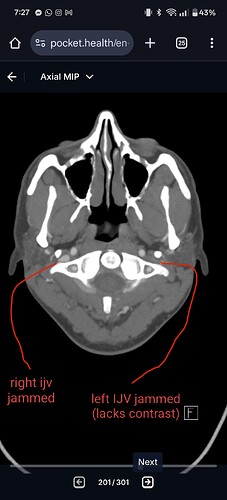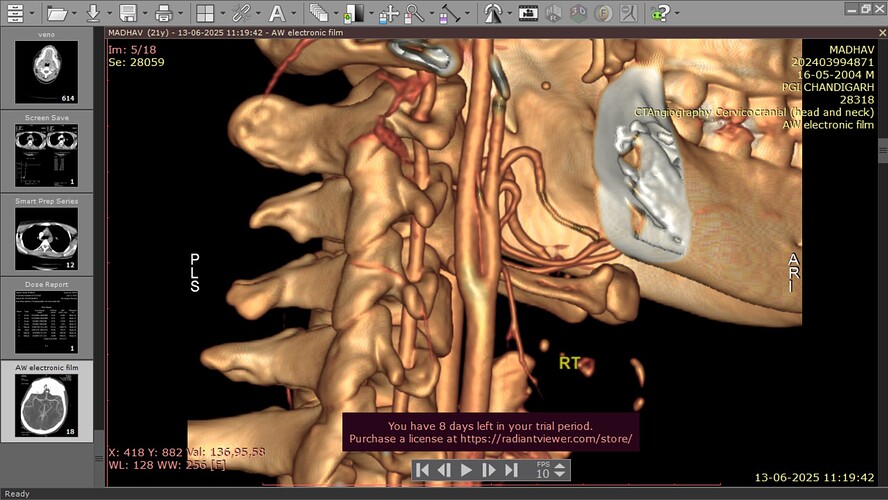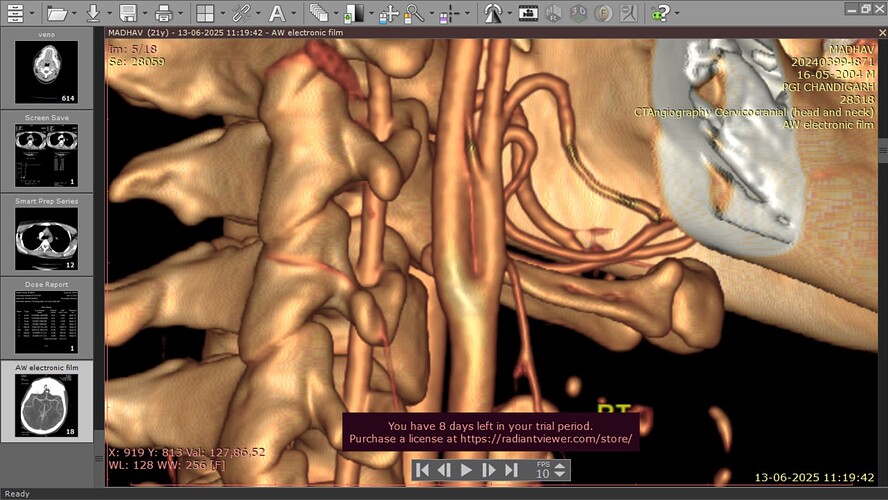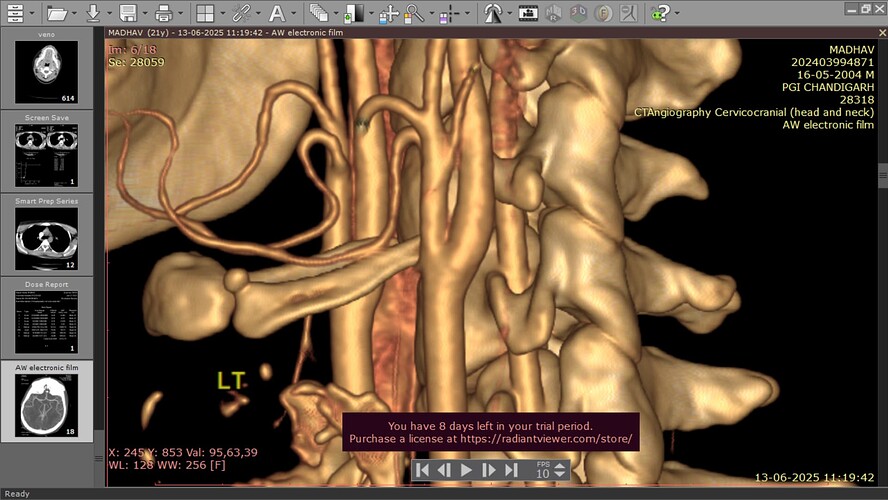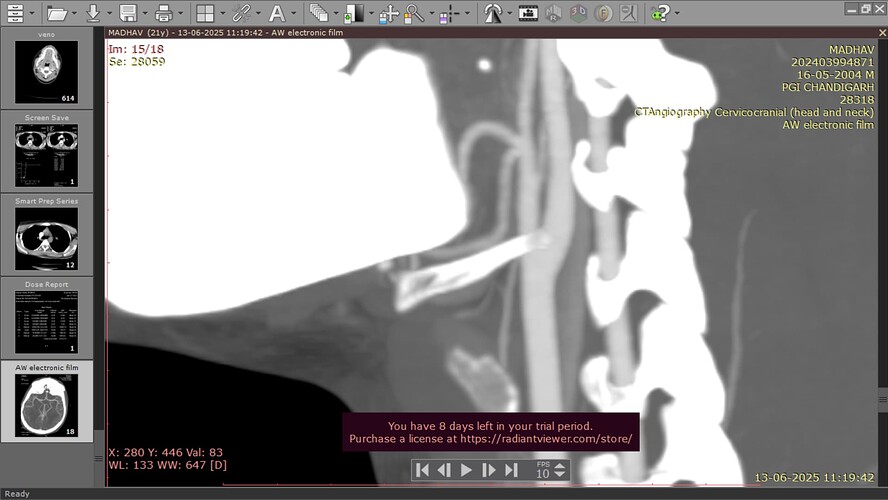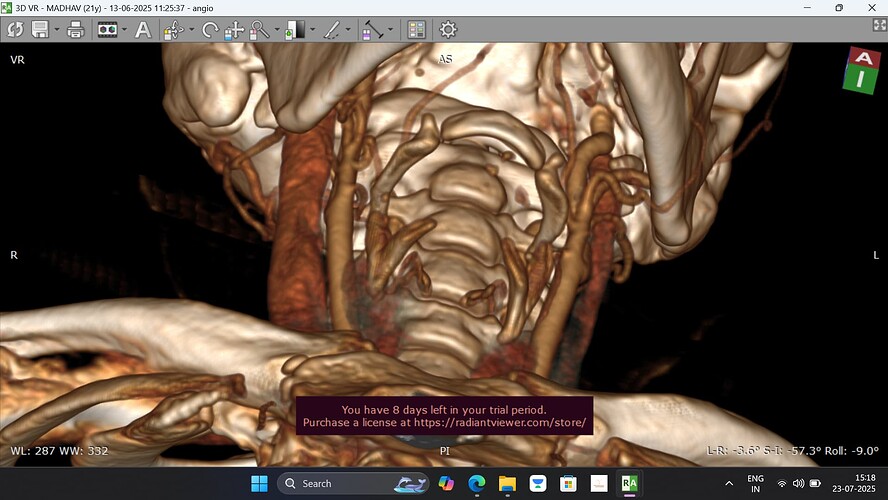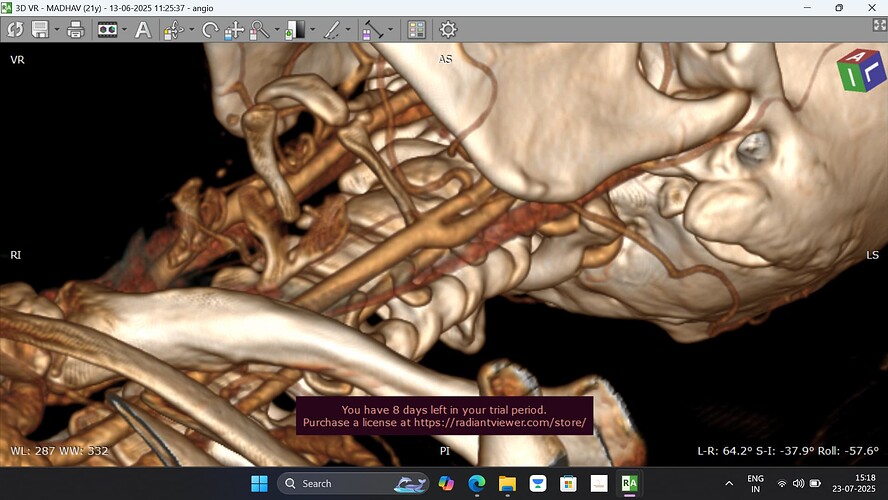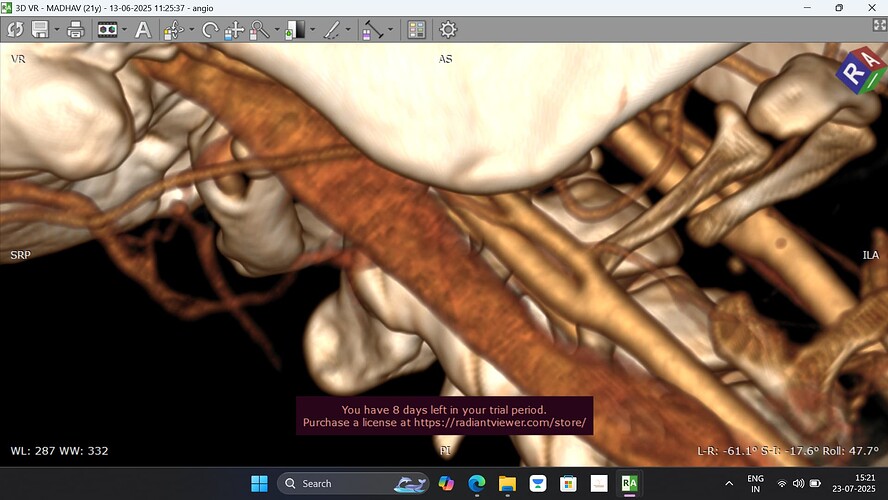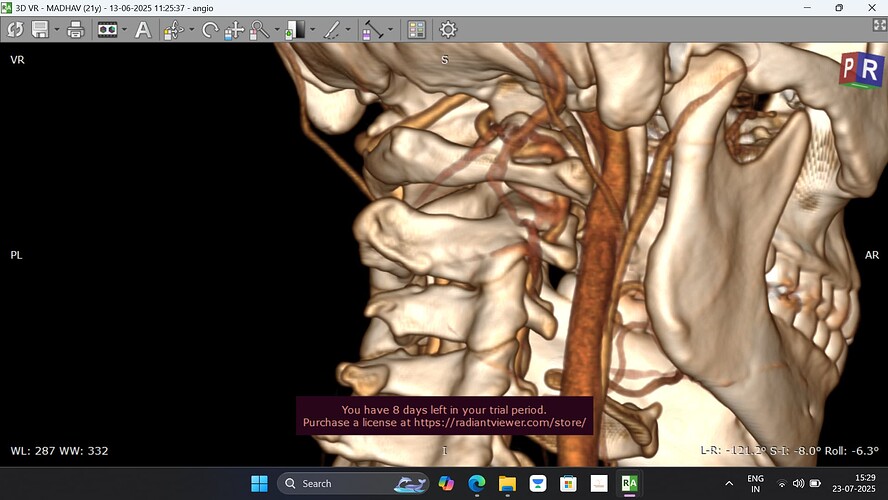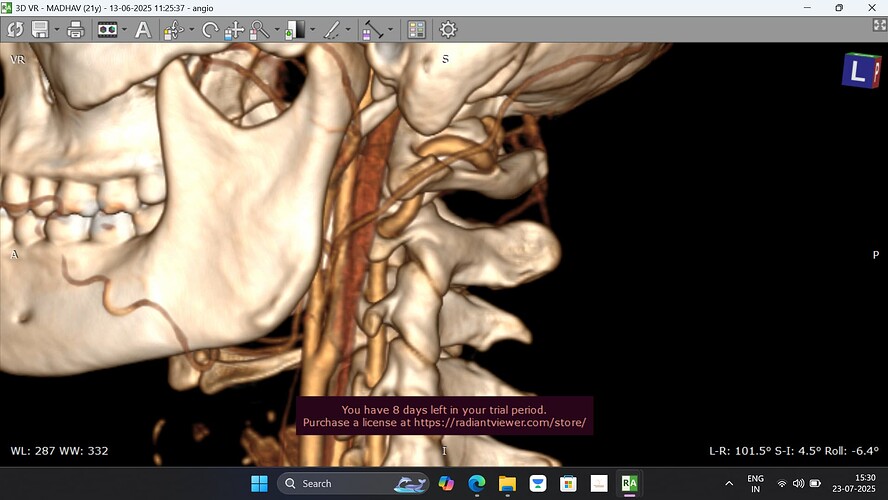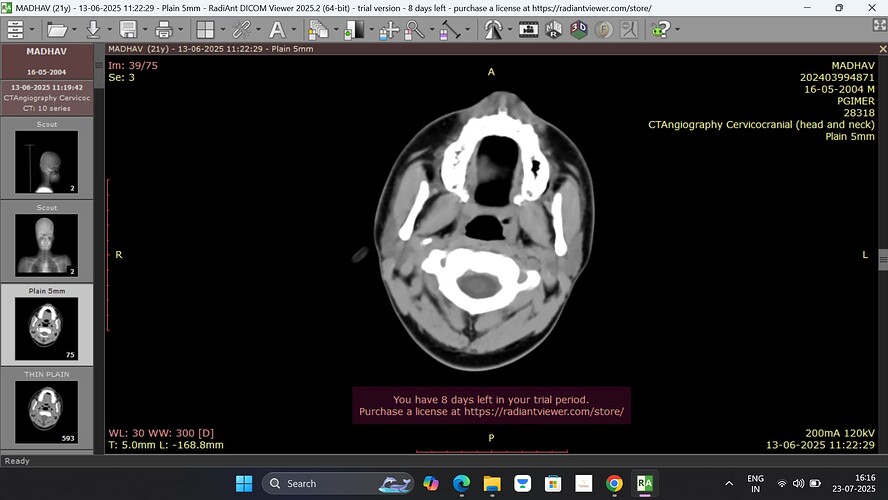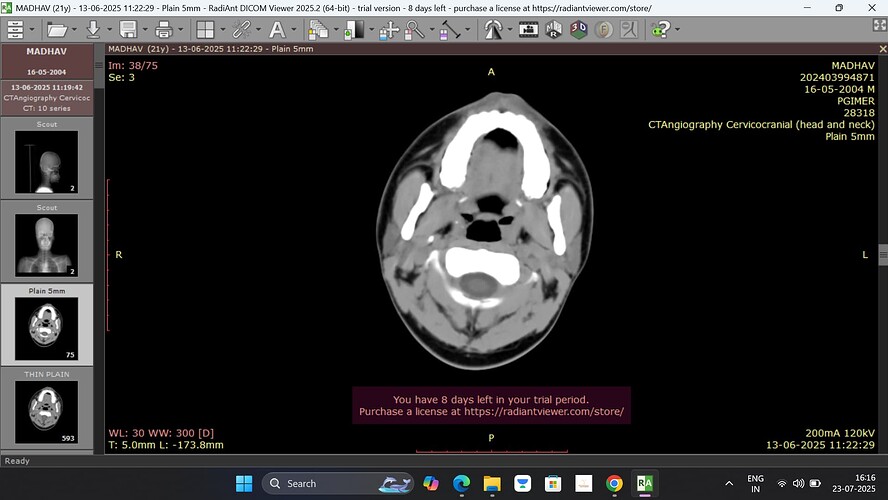@BraveKat See attached annotated versions of two of the three images you uploaded (third one doesn’t add anything significant). At the level of C1 there seems to be at least some compression of your LEFT IJV between C1 and your left styloid (ct images are reversed, so the right side of the image is actually your left side of body). I’m not seeing anything at the level of your hyoid of concern. That’s not to say nothing is going on down there, just can’t see anything in this exact slice. Not sure if your symptoms are all due to your left ijv at the level of C1. It is possible that there is compression happening elsewhere as well (e.g., closer to skull base, SCM muscles further below hyoid bone, etc), or your symptoms are being caused by something else altogether. Your left IJV is the only thing that sticks out to me immediately, and it would be good to see how thick your left IJV is immediately above C1 to see just how much it is being compressed. Brain fog, dizziness, pressure headaches, eye pain, as well as other symptoms would all suggest IJV compression (intracranial hypertension). I just want to remind you that I am obviously not a radiologist, this is just me trying to communicate what I think I’m seeing!
Hi, and thank you so much for taking the time to look over these images. I had left styloidectomy surgery in November last year and finally got a new ct scan done this week which I am still awaiting the images for. I’m hoping I’ll be able to get into into RadiAnt to see how much was removed - the surgeons notes state he took it to the base leaving about 1 cm. I am back on nerve pain meds which is helping a tiny bit and the ct scan has ruled out infection so all I can think is that my incision is still healing along with the nerves in close proximity (as this is where a lot of my pain seems to stem from). My GP thinks perhaps the Hypoglossal nerve has been damaged (either during or after surgery) as it runs very close to my incision. The pain I get seems to be set off my using my tongue (swallowing, talking, singing is particularly bad etc) and I can feel a sharp pulling sensation on the left hand side of my throat when I move my tongue around.
A day or two after surgery the pain set in and I hadn’t experienced this pain prior. In saying that, I definitely found my voice would change
after using it for a few minutes and my tongue was not able to extend out of my mouth very far. I also could not open my jaw more than 2cm (like it was restricted by something). So maybe there was already damage but something more has happened to it during the surgery…
I am also still having a lot of trouble with my Spinal Accessory Nerve. My vagus nerve has calmed a little from where it was pre-op which is good but still limits me a lot. I did have undiagnosed es for 12 years and was in a pretty horrible state per surgery so maybe I just need to wait a lot longer for nerves to heal and muscles to rebalance.
Have you had surgery yet or still searching for the right surgeon?
@BraveKat So I guess my detective work was correct in that your left styloid was causing IJV troubles. Glad to know I was on the right track. And glad to hear you got the left styloid removed! Sorry to hear that it’s still causing you difficulties though. When you get your hands on your new scan, if you upload a screen video of you slowly scrolling through the axial view from skull base all the way down past hyoid I can take a full length look at where your vagus, accessory, and hypoglossal nerves are!
I sent my CT scans off to Dr. Cognetti in Philadelphia a month or two ago. He has me book for an initial, but it isn’t until January unfortunately. I’m experiencing a lot of the IJV compression symptoms (much like you my left IJV at C1 is to blame), and my left greater horn of hyoid is jamming into the area of my carotid sinus causing a bunch of pre-stroke symptoms when I turn my head the wrong way, swallow or yawn with my head turned, etc. I’m basically a walking floor board until January I guess. I’m in Canada so things are tricky here medically. I did send of my CT to a second opinion radiology company specifically asking about the hyoid bone (I’ve given up on trying to convince Canadian professionals about ES/IJV compression). I’m hoping I can get the hyoid dealt with here as it’s a less complicated surgery and it would be free if I can get it done here. I’ll get the ES surgery with Dr. Cognetti as I trust him and don’t trust a Canadian surgeon to do them anyway.
From long 3 years i’m suffering from dizziness,lack of concentration,brain fog…clicking,popping, grinding sound from my hyoid bone…pls check from my scans what problem i facing @BraveKat @churchyardyew @Isaiah_40_31 @KarenG is it greater horn calcification or styloid process behind such neurological symptoms.Size of my right styloid is 42mm and on left it is 30mm
You’re right, it’s definitely a hyoid bone problem. You may have some secondary things going on as well, possibly CCI, but it looks to me like the hyoid is the root cause. It’s encountering your carotid sheath and even your spine. Call Dr. Dewan‘s office, say you’re coming internationally, and you need to make all the arrangements to get her your information and scans and be seen. I know she has seen people from as far away as Australia pretty sure they’re in this group, but not sure if their username. Sorry I seem a little spotty. I’m having a totally different health issue and I can’t be upright or on the phone for very long. If you could figure out who it was that saw her internationally and ask them what they did to secure the appt etc, I think that would make the most sense logistically. God knows it was difficult enough even in the US to communicate with her office. They’re all great. It’s just the way that the systems are set up is not ideal. I’m so sorry you’ve been suffering with this for so long. It definitely shows in how built up the hyoid is. Make sure you have all the scans on disk and stuff because this is what Dr. dewan will need to plan your surgery. specifically she needs a CT with contrast or a CTA. Sorry for any typos I’m using speech to text on my phone.
Your hyoid bone looks like it is in 3 pieces (the horns are not fused to the body) on the 3D scans. I think it is supposed to be in 1 horseshoe shaped piece. Need to see clear axial views to confirm. If the horns are not fused, it can definitely be putting presure on the the carotids under function. Worth checking out.
The hyoid doesn’t normally fuse until middle age (you can look up the specific timeline) so I don’t think that’s part of the clinical picture per se. The issue is its length, that it clearly reaches the carotid sheath. ![]()
@churchyardyew - I’m sorry to hear you’ve got something else going on now that’s causing you trouble. I hope you’re able to get a diagnosis & can recover so you can be up & around again before long. ![]()
![]()
Thank you! Yeah, totally unrelated – cranial CSF leaks. EDS is the gift that keeps on giving. ![]() I’m still doing great after the hyoid surgery and actually saw Dr. Fargen in NC to discuss ongoing outflow issues a few weeks ago. He confirmed with an angiogram that my jugulars are COMPLETELY decompressed by cutting the SH ligament, so I no longer have jugular issues (or vascular ES, technically). What I’m experiencing in terms of outflow symptoms is actually from a CSF issue (Chiari blocking outflow from the foramen magnum and then there are injuries to my facial bones and CSF is leaking out there). So anyway, I’m having to lay down frequently, once I get things patched up I will be a little more responsive.
I’m still doing great after the hyoid surgery and actually saw Dr. Fargen in NC to discuss ongoing outflow issues a few weeks ago. He confirmed with an angiogram that my jugulars are COMPLETELY decompressed by cutting the SH ligament, so I no longer have jugular issues (or vascular ES, technically). What I’m experiencing in terms of outflow symptoms is actually from a CSF issue (Chiari blocking outflow from the foramen magnum and then there are injuries to my facial bones and CSF is leaking out there). So anyway, I’m having to lay down frequently, once I get things patched up I will be a little more responsive. ![]() Hope you are doing okay, @Isaiah_40_31 !! Thanks for all you do!!
Hope you are doing okay, @Isaiah_40_31 !! Thanks for all you do!!
All is well here ![]() . What a challenge EDS provides for so many of our members! I’m sorry for the CSF leaks & hope Dr. Fargen or someone else can get it/them patched ASAP! Glad you know what’s causing your current symptoms as that’s always the hurdle that needs to be jumped before treatment can take place.
. What a challenge EDS provides for so many of our members! I’m sorry for the CSF leaks & hope Dr. Fargen or someone else can get it/them patched ASAP! Glad you know what’s causing your current symptoms as that’s always the hurdle that needs to be jumped before treatment can take place.
@churchyardyew - Please let us know when your surgery will be. I’ll pray for you in the meantime for it to go well & for the patches to stay put so your health can finally rally. ![]()
@Rex , the hyoid usually fuses in adulthood, but doesn’t always, I saw some research recently which stated I think about one third of people don’t have a fused hyoid, I don’t think it’s necessarily contributing to symptoms, as @churchyardyew says…
@churchyardyew , so sorry that you’re having EDS & Chiari issues, that’s really rough ![]()
i am so glad to hear you are doing well!! you deserve it!! thanks for your well wishes!! hopefully surgery will be in a few months. we are still searching for a surgeon or surgical team capable of dealing w this, it is very complex. but hey, i am thankful that i can swallow and that my carotids and jugulars are decompressed!! ![]()
I understand the hyoid may not fuse until later in life or not at all. I do think that the clicking and popping at the hyoid which Madhav stated could be from the unfused hyoid bone. I feel with it being unfused there is more mobility under function of the greater horns to possibly encroach upon the carotids compared to one solid horeshoe shape. I do not think that this is this issue with the other symptoms of brain fog, dizziness, etc… which probably is from venous vasuclar compression left side.
Have you had clicking hyoid syndrome? At least in my case, the clicking was coming from wherever the cartilage was built up (the ends of the greater horns) basically scraping over structures, not from where the greater horn would fuse or not fuse to the body of the hyoid. Since Madhav is younger according to their profile it is a good sign and totally typical that the hyoid isn’t fused. For me one side had fused and the other side hadn’t, and in my case that was indicative of asymmetrical strain and trauma, but wasn’t driving the clicking or creating the clicking in any way. So actually, it would be a bad sign if one or both sides were fused in a young patient. I hope this helps clarify why I’m saying it’s not relevant to the clinical picture
@Rex -I understand what you’re saying i.e. that w/o being fused to the body of the hyoid each of the greater horns has greater freedom of movement & thus has the opportunity to be causing trouble they might not be able to cause if they were solidly fused to the body of the hyoid. Your perspective does make sense.
@churchyardyew - I love your optimistic response ![]() . I’ll be praying for the proper medical team to be assembled ASAP & that your surgery will be life giving for you.
. I’ll be praying for the proper medical team to be assembled ASAP & that your surgery will be life giving for you. ![]()
@Rex this is important to understand otherwise you could be misinterpreting scans. The hyoid doesn’t fuse until middle age, like 40s, 50s, if ever. What is connecting those three pieces of the hyoid is cartilage. It’s not like the bones are disconnected. There’s a strong cartilaginous connection that becomes increasingly firm and eventually calcifies as people age. While it is possible for cartilage to dehisc, the separation would be much greater if that was the case, probably with the greater horn in question essentially falling down. Actually, being on the younger side with fusion of the greater horns is actually a better indicator that something is wrong with your hyoid because that indicates that your neck has been receiving long-standing mechanical strain or was subject to trauma. I just want to clarify that the cartilaginous connections allow the hyoid to expand horizontally as someone grows during childhood and adolescence but it’s not an articulatory joint and if there was dehiscence, allowing articulation, you would see the greater horn “falling down”. I just want to clarify on this point because otherwise you could think that almost every scan that you looked at was a candidate for clicking hyoid because the hyoid shouldn’t be fused in healthy individuals younger than middle age.
Thank you for your explanation @churchyardyew. That makes a lot of sense, as well. Most of our members who’ve had hyoid troubles, have also lost their cervical curve which I think also contributes to the anatomy changing such that the greater horns (depending on their length, angle of growth, etc) are moved into closer contact w/ the carotids, cervical spine & local nerves. That may explain why we’re seeing more people w/ potential HBS recently.
yeah, I think there could be a variety of things going on. instability or strain may cause the hyoid to elongate and/or cause the syloids to elongate and/or reduce the cervical curve. So anything from CCI, craniocervical syndrome, “text neck”, TMJ disorders, obstructive sleep apnea, anything damaging or straining the laryngeal or extra laryngeal musculature, etc etc could drive this kind of thing. what causes clicking hyoid, carotid sinus syncope, etc. etc. is the relative position of the hyoid(/thyroid/styloids/sh ligaments) to nerves/blood vessels/vertebrae/muscles that the hyoid is unfortunately encountering when it’s not supposed to be.
I feel there also seems to be an increase in connective tissue disorders, which can kind of set the stage for these conditions or make one more amenable to developing these conditions.
I mean, I think we’re all doing a massive social experiment with respect to the use of smart phones and laptops. poor posture and ergonomics can kind of lay the foundations and then all it takes is a head/neck injury…
My question: Is the increase in connective tissue disorders due to better diagnostic methods/practices &/or in part due to the “forward head posture” lifestyle so many people are now living? I’m guessing it’s a bit of both.
I totally agree. I found this article my mom had cut out of her newspaper in probably 2014 or 2015 (sorry no date on the article) which demonstrated early insight & recognition of how our computers, phones, gaming habits, etc. are negatively impacting our bodies in a profound way:


